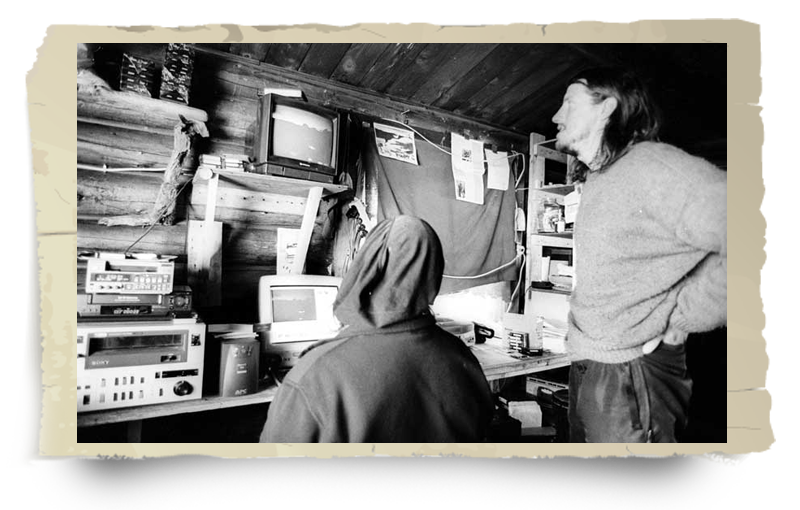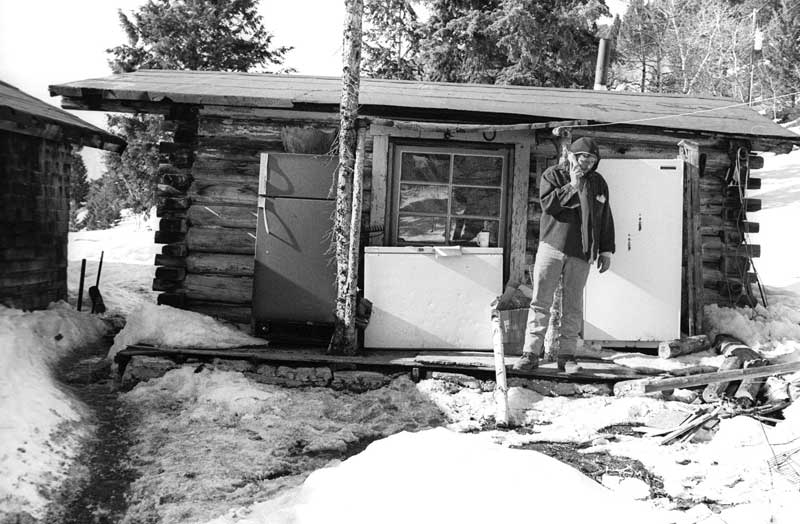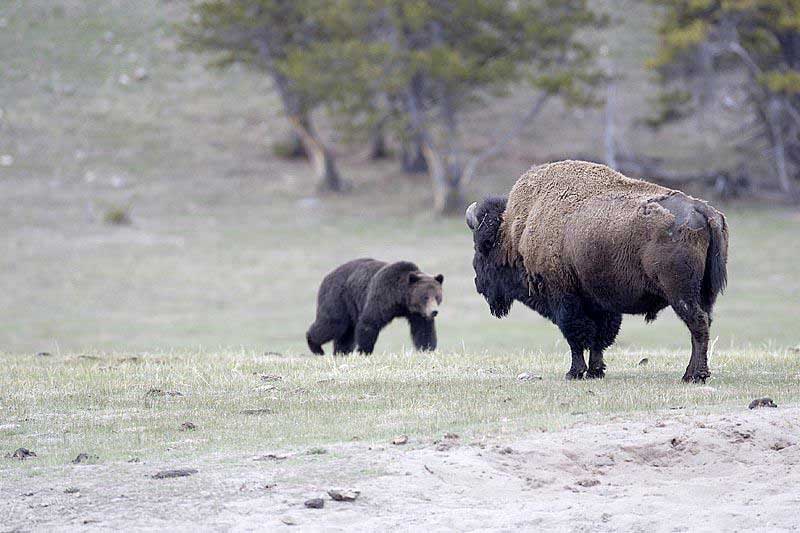A non-legalese introduction for you
The state and federal legal aspects of buffalo protection, and implications of these activities, are immense. In fact, this part of our work is so vast—so incredibly packed with documents, drudgery, and details—that we can never do our fabulous legal team justice in describing their work to you. Simply put: They balance the scales of activism and fairness quite effectively, but it is difficult to summarize their efforts.
Our teams work year-round to challenge and change policies that, since the year 2000 alone, have resulted in the senseless slaughter of thousands of Yellowstone bison. To fight the senseless slaughter, we attend public hearings and conferences where we present and submit comments on buffalo management decisions. We also work through the courts to uphold or dispute laws and contest management actions—and at the state and national levels to craft legislation to stop the slaughter and protect buffalo.
 Much of the preparation for our legal battles is done behind the scenes by BFC’s fantastic team of activists and experts.
Much of the preparation for our legal battles is done behind the scenes by BFC’s fantastic team of activists and experts.
BFC is very fortunate to have had many animal welfare and environmental law students volunteer with us in various capacities. Now, years later, we reap the benefit of a well-educated and well-placed legal support system. We do have to pay for some services, but generally receive about four dollars of legal guidance, research, and representation for every actual dollar invested.
It would be simple for us to “bury you” with PDF versions of court proceedings, records, and information requests (because we have tons!), but that would not necessarily help you understand this vital and time-consuming part of our buffalo conservation efforts.
Instead, we will describe to you the general kinds of legal actions we are involved in, share a few examples, encourage you to subscribe to our email updates if you have not already done so. It is through our regularly emailed communications that you can best track along with our legal proceedings as they, um, proceed!
Please also note that if it is beneficial for the buffalo, we sometimes join forces with other entities (mostly allied nonprofits) to pool efforts and strengthen legal outcomes for the herds.
Freedom of Information Act (FOIA)
This is at the top of the Legal section for good reason. Accurate information, whether scientific data or fiscal reports, is key to an effective legal strategy. Your legal eagles at BFC have become experts on use of the Freedom of Information Act to gather baseline data from the US Forest Service, US Department of Interior, and Yellowstone National Park on land use within the Yellowstone bison herd's native range.
The (federal) Freedom of Information Act (FOIA) has provided the public the right to request access to records from any federal agency since 1967. It is often described as the law that keeps citizens in the know about their government. Federal agencies are required to disclose any information requested under the FOIA unless it falls under one of nine exemptions intended to protect interests such as personal privacy, national security, and law enforcement. FOIA is a vital part of our democracy, as recognized by Congress, the President, and the Supreme Court.
BFC initiates a great many FOIA requests, as well as follow-ups seeking additional information and responses from government agencies such as referrals, redacted records (meaning with sections “blacked out”), and public records destroyed by the US Forest Service.
 It takes a great deal of patience to effectively work through the legal system. Our base camp phones are busy!
It takes a great deal of patience to effectively work through the legal system. Our base camp phones are busy!
We also continue to fight for the release of public records to be free of the current mandatory fees in cases (such as ours) where the public interest is served by such disclosure; there are precedents for fee waivers of this kind. Through this action we fight not only for wild buffalo, but for everyone who is influenced by the actions of the United States federal government.
As we list some of our suits, cases, and efforts below, please note that each of them probably required multiple FOIA requests as a part of the process.
Montana “Right to Know”
This is the State of Montana’s FOIA equivalent. We use it frequently as well, because the Montana Department of Livestock often does not respond to our repeated requests to inspect and copy public records on the agency's Yellowstone bison “management” activities. Specifically, two of the most relevant sections in the “Right to Know” law state:
"ARTICLE II, Section 9. Right to know. No Person shall be deprived of the right to examine documents or to observe the deliberations of all public bodies or agencies of state government and its subdivisions, except in cases in which the demand of individual privacy clearly exceeds the merits of public disclosure."
and
"MCA 2-6-102. Citizens entitled to inspect and copy public writings. (1) Every citizen has a right to inspect and take a copy of any public writing of this state."
In some cases, information obtained through our “Right to Know” requests that have led to the need for more requests—or even legal action—simply to gain access to additional public documents that we learn about through our first request! Whew! The buffalo are lucky that our team includes people with determination, tenacity, and attention to detail!
Public Trust and Quarantine Suit
One example of a state-level effort is a suit we filed against the State of Montana and Montana’s Department of Fish, Wildlife & Parks. We sought to protect quarantined bison and protect the public trust by securing public access to bison and preventing the ghastly “privatization” of Yellowstone buffalo calves.
Habitat Access Lawsuit
Here in Montana, U.S. District Court Judge Charles C. Lovell heard arguments for summary judgment in a lawsuit filed by a coalition of conservation groups (including BFC), Native Americans, and other Montanans. The suit was against Yellowstone National Park and the Gallatin National Forest for harming wild bison and associated species because:
- U.S. Forest Service (USFS) decisions were precluding native bison and associated species from occupying and using Gallatin National Forest lands;
- USFS was not managing habitat for bison, and not ensuring viable populations of bison and associated species could exist on the land in Gallatin National Forest; and
- National Park Service decisions caused impairment and/or unacceptable impacts to native bison populations by allowing the wanton destruction of wild bison and not conserving the wildlife species.
We asked for court review of both agencies' refusal to analyze and disclose new information and changed circumstances relating to bison management and brucellosis, and asked that the federal agencies be required to take a hard look at environmental impacts and make informed decisions with the best available science about wild bison and related species in the Yellowstone ecosystem.
Litigation against impact of buffalo “hazing” operations on endangered species
The waste and cruelty of the Interagency Bison Management Plan (IBMP) goes far beyond the impact to buffalo. As buffalo are chased with a wide variety of land and airborne vehicles, everything in the hazing area is affected.
 Buffalo are just one of MANY Yellowstone species negatively impacted by hazing operations.
Buffalo are just one of MANY Yellowstone species negatively impacted by hazing operations.
Numerous officially listed endangered and threatened species live in Yellowstone, and suffer under the practices of the IBMP. Federally protected grizzly bears are frequently threatened by bison hazing operations, and in fact we submitted a FOIA request to United States Department of Agriculture’s Animal and Plant Health Inspection Service (APHIS) seeking records on APHIS Decision Memos, any National Environmental Policy Act (NEPA) analysis, and U.S. Fish and Wildlife Service (USFWS) consultation on helicopter hazing of bison and impacts to threatened grizzly bears.
Then our work in the courts (supported by evidence gathered by our field patrols) resulted in the grounding of the Department of Livestock (DOL) helicopter—one of the most formidable tools used against the buffalo. When shown evidence directly obtained and provided by BFC proving the helicopter was harming federally-designated-as-threatened grizzly bears in the spring, a federal judge ordered the DOL not to use it. Later, the DOL announced that the “helicopter hazing program has ended and no longer exists." The power and precedent of this success, and the positive impact for wild animals throughout the region, was enormous. Unfortunately, in a later court ruling the judge ruled against BFC, the buffalo, and the bears, and the DOL again uses the helicopter for hazing operations. This battle continues.
Grizzlies are just one example of an endangered species, but another (no longer endangered) species often impacted is the American bald eagle. We obtained video footage of a Montana Department of Livestock (DOL) helicopter landing in a Bald Eagle Closure Area during a bison hazing operation. The video clearly shows the DOL helicopter landing, taking off, and flying through the Bald Eagle Closure Area and around the Horse Butte nest. The Horse Butte bald eagle nest failed to produce eaglets that spring.
Since their removal from the Endangered Species Act, bald eagles are primarily protected under the Bald and Golden Eagle Protection Act, and the Migratory Bird Treaty Act. The Bald and Golden Eagle Protection Act and its implementing regulations prohibit the killing of bald eagles, as well as banning activities that are likely to interfere with eagles’ breeding, feeding or sheltering behavior, or result in injury, death, or nest abandonment. Flying a helicopter through a designated closure area that was created to protect them, and flying around an active nest are, in our humble legal opinions, clearly in violation of the law.
Endangered Species Act
This is the most daunting goal we have ever set for ourselves: obtaining Endangered Species Act (ESA) "threatened" or "endangered" status for the genus "Bison Bison" (i.e., the Yellowstone buffalo). However, it is also the most broad-reaching and longest-lasting protection we could hope to achieve for the last wild buffalo herds. This project absorbs a great deal of time and resources, and is complex enough that we have created a special page about it.
Public Comments
A part of a significant decision-making process for many publically-funded agencies is the “Public Comment Period.” Generally, these are designed as a part of open public meetings of government bodies, and they set aside time for oral public comments, written comments/documents, or both. Our Public Comments are here for your reference.
For any such public meeting or comment period relating to the Yellowstone buffalo (genus “Bison Bison”), BFC participates and shares as much relevant information as possible. We maintain a positive outlook, and know that some people—when shown the objective facts—will make the right decision. It is for this reason that we generously allocate our time to participating in this civic process at all levels: regional, state, and national. If you are interested in participating, please know that when we learn of opportunities for public participation we will reach out to you loudly and clearly, and hope you will raise your voice with ours in defense of wild buffalo! The best way to remain current, and keep yourself involved is by signing up for our enews!
Working with the Yellowstone regional community
In the winter of 2012/13, Montana announced plans to permit a few buffalo access to the Gardiner basin, a small part of the buffalo’s historic winter range in Park County, Montana.
A lawsuit by Park County and the Park County Stockgrowers challenged even this small bit of tolerance for wild buffalo. BFC and others successfully intervened on behalf of area residents who welcome the return of bison along the Yellowstone River Corridor. As a result, in January 2013 a Montana district judge ruled against the Stockgrowers and for the pro-bison residents and BFC, upholding the buffalo’s right to roam! This eliminated a multitude of hazing operations, saved taxpayers a vast expense, and greatly reduced buffalo stress, suffering, and death.
There you have it!
As we’ve said: there is so much more to this than we can explain to you. This information simply offers you “a glimpse into the legal machine” that we’ve created to help protect this magnificent creature.
Unfortunately, the many activities described here for you are not cheap. We have a great many fine people, and lots of them working for free—but our expenses, especially for the ESA listing—are enormous. Will you help the buffalo by pitching in to cover these costs with your generous donation today?








